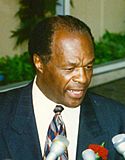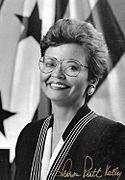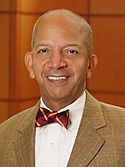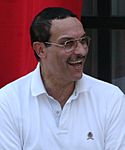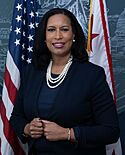List of mayors of Washington, D.C. facts for kids
This page lists the leaders of Washington, D.C. over time. These leaders have had different titles, like commissioners, governors, and mayors.
Contents
- How D.C. Was Governed
- Early Commissioners of the Federal City (1791–1802)
- Mayors of the City of Washington (1802–1871)
- Mayors of Georgetown (1790–1871)
- Governors of the District of Columbia (1871–1874)
- Temporary Commissioners of D.C. (1874–1878)
- Presidents of the Board of Commissioners (1878–1967)
- Mayor-Commissioner (1967–1975)
- Mayors of the District of Columbia (1975–present)
- See also
How D.C. Was Governed
The area that became Washington, D.C., was first chosen in 1790. At that time, the President picked three people, called commissioners, to find and plan the capital city. From 1791 to 1802, these three commissioners managed the area.
In 1801, the U.S. Congress took direct control of the District. The Board of Commissioners was ended. The District then had five parts: three cities with their own local governments and two rural counties. The cities were Georgetown, Alexandria, and the new City of Washington. Each city had its own mayors. The two counties were Alexandria County (in what is now Virginia) and Washington County, D.C. (in what is now Maryland).
In 1846, Alexandria County and the City of Alexandria became part of Virginia again. This left D.C. with two cities and one county.
In 1871, all these parts of D.C. were brought together under one government. This new government was led by a Governor. Only two governors served before this system changed in 1874. After that, a temporary group of three commissioners, chosen by the President, took over. This group became permanent in 1878 and lasted until 1967.
In 1967, a single mayor-commissioner and a city council, all appointed by the President, replaced the three-commissioner system. Finally, in 1974, a law called the District of Columbia Home Rule Act allowed D.C. residents to vote for their own mayor.
Today, the Mayor of the District of Columbia is chosen by voters for a four-year term. There's no limit to how many terms a mayor can serve. Even though D.C. is not a state, its government handles many responsibilities similar to those of state governors. The current mayor of D.C. is Muriel Bowser, who is a Democrat. She has been mayor since January 2, 2015.
This page lists all the main leaders of the District of Columbia in their different roles.
Early Commissioners of the Federal City (1791–1802)
In 1790, a law created a group of three commissioners. Their job was to plan the new capital city, buy land, and oversee the building of federal buildings. These commissioners didn't manage the daily city rules much. Their powers were later given to other officials. Local matters were handled by a "Levy Court" made up of Justices of the Peace.
| # | Image | Member | Term began | Term ended | State | Political party |
|---|---|---|---|---|---|---|
| 1 |  |
David Stuart | January 22, 1791 | September 12, 1794 | Virginia | Independent |
| 2 |  |
Thomas Johnson | January 22, 1791 | August 23, 1794 | Maryland | Federalist |
| 3 |  |
Daniel Carroll | March 4, 1791 | May 21, 1795 | Maryland | Independent |
| 4 |  |
Gustavus Scott | August 23, 1794 | December 25, 1800 | Maryland | Independent |
| 5 |  |
William Thornton | September 12, 1794 | July 1, 1802 | Pennsylvania | Independent |
| 6 |  |
Alexander White | May 21, 1795 | July 1, 1802 | Virginia | Pro-Administration |
| 7 |  |
William Cranch | January 14, 1801 | March 3, 1801 | Massachusetts | Federalist |
| 8 |  |
Tristram Dalton | March 10, 1801 | July 1, 1802 | Massachusetts | Pro-Administration |
| Source: | ||||||
Mayors of the City of Washington (1802–1871)
The City of Washington got its own official government in 1802. The Mayor of Washington was in charge of city services and local taxes. However, their main job was to ask Congress for money to run the city.
From 1802 to 1812, the U.S. President chose the mayor. From 1812 to 1820, a city council picked the mayor. After 1820, people in the city voted for their mayor until 1871. The City of Washington was located between Rock Creek to the west, Florida Avenue to the north, and the Anacostia River to the east and south.
The County of Washington, which included the cities of Washington and Georgetown, was also governed by a Levy Court. This court was made up of Justices of the Peace chosen by the President. In 1871, the Levy Court and the City of Washington's mayor were ended when Congress combined all the remaining governments in D.C.
| Image | Mayor | Term began | Term ended | Political party |
|---|---|---|---|---|
 |
Robert Brent | June 1, 1802 | June 8, 1812 | Democratic-Republican Party |
 |
Daniel Rapine | June 8, 1812 | June 14, 1813 | Independent |
 |
James H. Blake | June 14, 1813 | June 9, 1817 | Independent |
 |
Benjamin G. Orr | June 9, 1817 | June 14, 1819 | Independent |
 |
Samuel N. Smallwood | June 14, 1819 | June 14, 1822 | Independent |
 |
Thomas Carbery | June 14, 1822 | June 14, 1824 | Independent |
 |
Samuel N. Smallwood | June 14, 1824 | September 30, 1824 | Independent |
 |
Roger C. Weightman | October 4, 1824 | June 11, 1827 | Independent |
 |
Joseph Gales | June 11, 1827 | June 14, 1830 | Independent |
 |
John Peter Van Ness | June 14, 1830 | June 9, 1834 | Democratic-Republican |
 |
William A. Bradley | June 9, 1834 | June 13, 1836 | Independent |
 |
Peter Force | June 13, 1836 | June 8, 1840 | Whig Party |
 |
William Winston Seaton | June 8, 1840 | June 10, 1850 | Whig Party |
 |
Walter Lenox | June 10, 1850 | June 14, 1852 | Independent |
 |
John W. Maury | June 14, 1852 | June 12, 1854 | Democratic |
 |
John T. Towers | June 12, 1854 | June 9, 1856 | Know Nothing |
 |
William B. Magruder | June 9, 1856 | June 14, 1858 | Anti-Know-Nothing-Party |
 |
James G. Berret | June 14, 1858 | August 26, 1861 | Anti-Know-Nothing-Party, Democratic |
 |
Richard Wallach | August 26, 1861 | June 8, 1868 | Republican |
 |
Sayles J. Bowen | June 8, 1868 | June 7, 1870 | Republican |
 |
Matthew G. Emery | June 7, 1870 | February 28, 1871 | Republican |
| Source: | ||||
Mayors of Georgetown (1790–1871)
Georgetown was a town in Maryland before 1801. It then became a city within the District of Columbia. From 1802 to 1871, Georgetown's mayors were elected for one-year terms. There were no limits on how many terms they could serve. Like the City of Washington, Georgetown's local government ended in 1871. This happened when Congress combined the three separate areas into one D.C. government.
| # | Image | Mayor | Term began | Term ended |
|---|---|---|---|---|
| 1 |  |
Robert Peter | 1790 | 1791 |
| 2 |  |
Thomas Beale | 1791 | 1792 |
| 3 |  |
Uriah Forrest | 1792 | 1793 |
| 4 |  |
John Threlkeld | 1793 | 1794 |
| 5 |  |
Pedro Casenave | 1794 | 1795 |
| 6 |  |
Thomas Turner | 1795 | 1796 |
| 7 |  |
Daniel Reintzel | 1796 | 1797 |
| 8 |  |
Lloyd Beall | 1797 | 1799 |
| 9 |  |
Daniel Reintzel | 1799 | 1804 |
| 10 |  |
Thomas Corcoran | 1805 | 1806 |
| 11 |  |
Daniel Reintzel | 1806 | 1807 |
| 12 |  |
Thomas Corcoran | 1808 | 1810 |
| 13 |  |
David Wiley | 1811 | 1812 |
| 14 |  |
Thomas Corcoran | 1812 | 1813 |
| 15 |  |
John Peter | 1813 | 1818 |
| 16 |  |
Henry Foxall | 1819 | 1820 |
| 17 |  |
John Peter | 1821 | 1822 |
| 18 |  |
John Cox | 1823 | 1845 |
| 19 |  |
Henry Addison | 1845 | 1857 |
| 20 |  |
Richard R. Crawford | 1857 | 1861 |
| 21 |  |
Henry Addison | 1861 | 1867 |
| 22 |  |
Charles D. Welch | 1867 | 1869 |
| 23 |  |
Henry M. Sweeney | 1869 | 1871 |
Governors of the District of Columbia (1871–1874)
In 1871, Congress created a new government for the entire District of Columbia. This government was led by a governor chosen by the President for a four-year term. However, this government faced problems with how it was run. Because of these issues, the governor system was stopped in 1874.
| # | Image | Governor | Term began | Term ended | Political party | |
|---|---|---|---|---|---|---|
| 1 |  |
Henry D. Cooke | February 28, 1871 | September 13, 1873 | Republican | |
| 2 |  |
Alexander R. Shepherd | September 13, 1873 | June 20, 1874 | Republican | |
Temporary Commissioners of D.C. (1874–1878)
From 1874 to 1878, D.C. was managed by a temporary group of three commissioners. These commissioners had both law-making and executive powers. They were all chosen by the President. There was no official president for this temporary board, but Commissioner Dennison often acted as the leader.
| # | Image | Member | Term began | Term ended | Political party | |
|---|---|---|---|---|---|---|
| 1 |  |
William Dennison | July 1, 1874 | July 1, 1878 | Republican | |
| 2 |  |
Henry T. Blow | July 1, 1874 | December 31, 1874 | Republican | |
| 3 |  |
John H. Ketcham | July 3, 1874 | June 30, 1877 | Republican | |
| 4 |  |
Seth Ledyard Phelps | January 18, 1875 | June 30, 1878 | Republican | |
| 5 |  |
Thomas Barbour Bryan | December 3, 1877 | July 1, 1878 | Republican | |
| Source: | ||||||
Presidents of the Board of Commissioners (1878–1967)
In 1878, the Board of Commissioners became a permanent system. From 1878 to 1967, D.C. was run by this three-member board. All members were chosen by the President. The board included one Democrat, one Republican, and one civil engineer (who didn't have a specific party). These three commissioners would then choose one of themselves to be the president of the board. The president of the board was the main leader of the District.
Denotes an Acting President
| # | Image | President | Term began | Term ended | Political party | |
|---|---|---|---|---|---|---|
| 1 |  |
Seth Ledyard Phelps | July 1, 1878 | November 29, 1879 | Republican | |
| 2 |  |
Josiah Dent | November 29, 1879 | July 17, 1882 | Democratic | |
| 3 |  |
Joseph Rodman West | July 17, 1882 | March 29, 1883 | Republican | |
| 4 |  |
James Barker Edmonds | March 29, 1883 | January 1, 1886 | Democratic | |
| 5 |  |
William Benning Webb | January 1, 1886 | May 21, 1889 | Republican | |
| 6 |  |
John Watkinson Douglass | May 21, 1889 | March 1, 1893 | Republican | |
| 7 |  |
John Wesley Ross | March 1, 1893 | June 1, 1898 | Democratic | |
| 8 |  |
John Brewer Wight | June 1, 1898 | May 9, 1900 | Republican | |
| 9 |  |
Henry Brown Floyd MacFarland | May 9, 1900 | January 24, 1910 | Republican | |
| 10 |  |
Cuno Hugo Rudolph | January 24, 1910 | February 28, 1913 | Republican | |
| 11 |  |
Oliver Peck Newman | February 28, 1913 | October 9, 1917 | Democratic | |
| 12 |  |
Louis Brownlow | October 9, 1917 | September 17, 1920 | Democratic | |
 |
Charles Willauer Kutz | September 17, 1920 | September 25, 1920 | Independent | ||
| 13 |  |
John Thilman Hendrick | September 25, 1920 | March 4, 1921 | Democratic | |
| 14 |  |
Cuno Hugo Rudolph | March 15, 1921 | December 4, 1926 | Republican | |
| 15 |  |
Proctor Lambert Dougherty | December 4, 1926 | April 10, 1930 | Republican | |
| 16 |  |
Luther Halsey Reichelderfer | April 10, 1930 | November 16, 1933 | Republican | |
| 17 |  |
Melvin Colvin Hazen | November 16, 1933 | July 15, 1941 | Democratic | |
| 18 |  |
John Russell Young | July 15, 1941 | July 29, 1941 | Republican | |
| July 29, 1941 | June 2, 1952 | |||||
| 19 |  |
F. Joseph Donohue | June 2, 1952 | April 6, 1953 | Democratic | |
| 20 |  |
Samuel Spencer | April 6, 1953 | April 6, 1956 | Republican | |
| 21 |  |
Robert E. McLaughlin | April 6, 1956 | July 27, 1961 | Republican | |
| 22 |  |
Walter Nathan Tobriner | July 27, 1961 | November 7, 1967 | Democratic | |
| Source: | ||||||
Mayor-Commissioner (1967–1975)
In 1967, President Lyndon Johnson changed D.C.'s government again. The three-commissioner system was replaced. A single mayor-commissioner, an assistant mayor-commissioner, and a nine-member district council now led the city. All these officials were chosen by the President.
The mayor-commissioner and assistant served four-year terms. Council members served three-year terms. The council had power to approve the budget and set property taxes. The mayor-commissioner could make changes to city agencies and move money between them. The mayor-commissioner could also reject council actions, but the council could overrule this with a three-fourths vote.
Walter E. Washington was the first mayor-commissioner. Thomas W. Fletcher was the first assistant mayor-commissioner.
| # | Mayor-Commissioner | Term start | Term end | Party | |
|---|---|---|---|---|---|
| 1 |  |
Walter Washington | November 7, 1967 | January 2, 1975 | Democratic |
Mayors of the District of Columbia (1975–present)
Since 1975, D.C. has been led by a mayor and a district council. Both are chosen by the people of D.C. through elections.
- Parties
Democratic (7)
| # | Mayor | Term of office | Party | Term | Previous office | |
|---|---|---|---|---|---|---|
| 1 |
|
Walter Washington (1915–2003) |
January 2, 1975 – January 2, 1979 |
Democratic | 1 (1974) |
Mayor-Commissioner of the District of Columbia |
| 2 |
|
Marion Barry (1936–2014) |
January 2, 1979 – January 2, 1991 |
Democratic | 2 (1978) |
Member of the Council of the District of Columbia from the at-large district (1975–1979) |
| 3 (1982) |
||||||
| 4 (1986) |
||||||
| 3 |
|
Sharon Pratt Kelly (born 1944) |
January 2, 1991 – January 2, 1995 |
Democratic | 5 (1990) |
Treasurer of the Democratic National Committee (1985–1989) |
| 4 |
|
Marion Barry (1936–2014) |
January 2, 1995 – January 2, 1999 |
Democratic | 6 (1994) |
Member of the Council of the District of Columbia from Ward 8 (1993–1995) |
| 5 |
|
Anthony A. Williams (born 1951) |
January 2, 1999 – January 2, 2007 |
Democratic | 7 (1998) |
D.C. Chief Financial Officer (1995–1998) |
| 8 (2002) |
||||||
| 6 |
|
Adrian Fenty (born 1970) |
January 2, 2007 – January 2, 2011 |
Democratic | 9 (2006) |
Member of the Council of the District of Columbia from Ward 4 (2001–2007) |
| 7 |
|
Vincent C. Gray (born 1942) |
January 2, 2011 – January 2, 2015 |
Democratic | 10 (2010) |
Chairman of the Council of the District of Columbia (2007–2011) |
| 8 |
|
Muriel Bowser (born 1972) |
January 2, 2015 – Incumbent |
Democratic | 11 (2014) |
Member of the Council of the District of Columbia from Ward 4 (2007–2015) |
| 12 (2018) |
||||||
| 13 (2022) |
||||||
See also
- Timeline of Washington, D.C.



